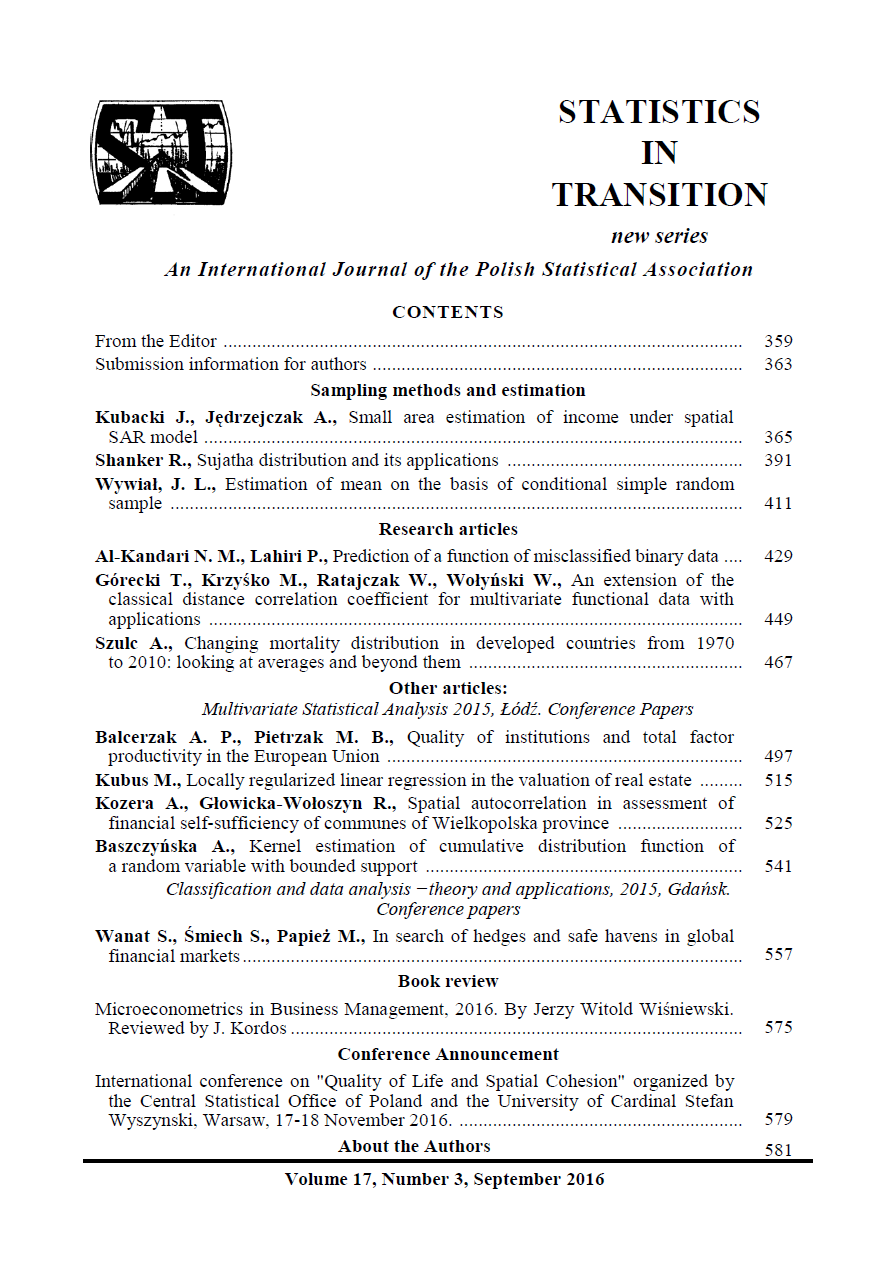ARTICLE
ABSTRACT
The methods typically developed in income inequality and poverty research are employed to observe changes in life spans distribution in 35 developed countries. The analyses are performed at two levels, using the same methods when possible: i/ taking the countries as the units with a mean length of life being a single parameter representing the distribution, ii/ utilizing the country life tables (taking people as the units) in order to compare other than mean length of life attributes of mortality distribution. Increasing divergence in the mean length of life across the countries is due to growing distance of the countries below the median, mainly the post-communist ones, to the upper half. The comparisons of the within-country distributions of ages at death by means of the Kullback-Leibler divergence provides similar results. However, poverty and inequality indices calculated at this level yield opposite conclusions. Hence, most of the between-country variation might be attributed to the variation in the mean length of life while the changes in within-country inequality reduced this effect. At the same time, huge alterations in the within-country mortality rankings can be observed. Australia, Japan, Taiwan, Austria and Luxembourg may be said to be the “winners” while most of the post-communist countries are among the “losers”.
KEYWORDS
mean length of life, mortality distribution, poverty and inequality indices.
REFERENCES
BILLINGSLEY, S., (2011). Exploring the conditions for a mortality crisis: bringing context back into debate. Population, Space and Place 17, pp. 267–289.
COWELL, F., (1977). Measuring Inequality, Philip Allan, Deddington, Oxon.
D'ALBIS, H., ESSO, L. J., PIFARRÉ, H., AROLAS, I., (2014). Persistent differences in mortality patterns across industrialized countries. PLoS ONE 9(9): e106176. doi:10.1371/journal.pone.0106176
EDWARDS, R. D., (2011). Changes in world inequality in length of life: 1970-2000. Populationand Development Review 37, pp. 499–528.
EDWARDS, R. D., TULJAPURKAR, S., (2005). Inequality in life spans and a new perspective on mortality convergence across industrialized countries. Population and Development Review 31, pp. 645–674.
ESTEBAN, J., D., RAY, (1994). On the measurement of polarization, Econometrica 62, pp. 819–851.
EUROPEAN COMMISSION, (2009). Portfolio of indicators for the monitoring of the European strategy for social protection and social inclusion – 2009 update. The Eurostat website.
FISHBURN, P. C., (1984). Transfer principles in income distribution. Journal of Public Economics 25, pp. 323–328.
HICKS, N., STREETEN, P., (1979). Indicators of development: the search for a basic yardstick. World Development 7, pp. 567–580.
HISNANICK, J. J., CODDINGTON, D. A., (1995). Measuring human betterment through avoidable mortality: a case for universal health care in the USA. Health Policy 34, pp. 9–19.
HUMAN MORTALITY DATABASE, (2011). University of California,Berkeley (USA), and Max Planck Institute for Demographic Research (Germany), www.mortality.org.
KORDA, R. J., BUTLER, J. R. G., (2006). Effect of healthcare on mortality: Trends in avoidable mortality in Australia and comparisons with Western Europe. Public Health 120, pp. 95–105.
KULLBACK, S., LEIBLER, R. A., (1951). On information and sufficiency. Annals of Mathematical Statistics 22, pp. 79–86.
MADDEN, D., (2000). Relative or absolute poverty lines: A new approach, Review of Income and Wealth 46, pp. 181–199.
MUSZYŃSKA, M., SZULC, A., JANSSEN, F., (2014). An index of inequality in age-at-death distributions across a group of countries based on the concept of the Equivalent Length of Life, paper presented at the European Population Conference 2014, 25–28 June, Budapest. http://epc2014.princeton.edu/papers/140389
PARETO, V., (1896). La courbe des revenus. Le Monde Economique, 1896.
RAVALLION, M., (1994). Poverty Comparisons. A Guide to Concepts and Methods, Living Standards Measurement Study, Working Paper, No. 88, The World Bank, Washington, D. C.
SEN, A., (1976). Poverty: an ordinal approach to measurement, Econometrica 44, pp. 219–231.
SEN, A., (1998). Mortality as an indicator of economic success and failure. The Economics Journal 108, pp. 1–25.
SILBER, J., (1983). ELL (the equivalent length of life) or another attempt at measuring development. World Development 11, pp. 21–29.
SILBER, J., (1992). Life tables and the measurement of the extent of poverty, Poverty Measurement for Economies in Transition in Eastern European Countries. International Scientific Conference, Warsaw, 7-9 October 1991, Warsaw 1992, pp. 411–431.
SMITS, J., MONDEN, C., (2009). Length of life inequality around the globe. Social Science and Medicine 68, pp. 1114–1123.
UNITED NATIONS DEVELOPMENT PROGRAMME, (2014). Human Development Reports, http://hdr.undp.org/en.
THEIL, H., (1967). Economics and Information Theory. Chicago: Rand McNally and Company.
WOLFSON, M. C., (1994). When inequalities diverge, The American Economic Review 84, pp. 353–358
